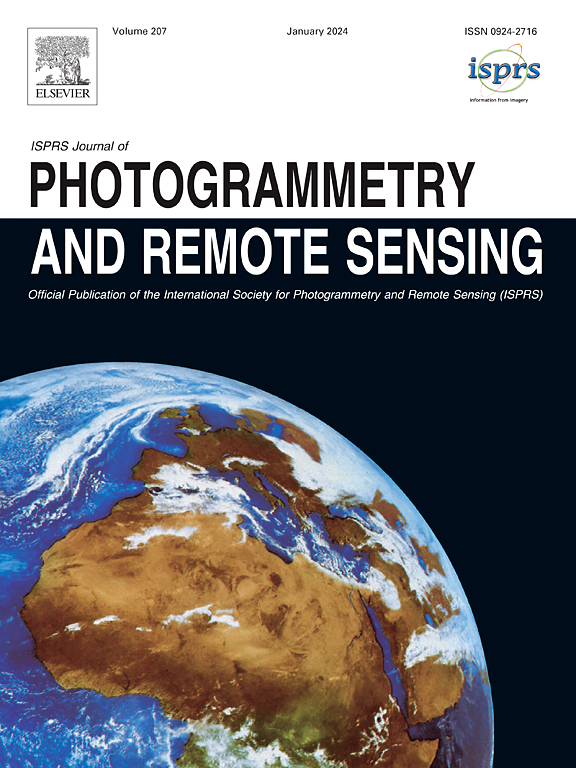Mapping seamless surface water dynamics over East Africa semimonthly at a 10-meter resolution in 2017–2023 by integrating Sentinel-1/2 data
IF 10.6
1区 地球科学
Q1 GEOGRAPHY, PHYSICAL
ISPRS Journal of Photogrammetry and Remote Sensing
Pub Date : 2025-05-15
DOI:10.1016/j.isprsjprs.2025.04.032
引用次数: 0
Abstract
Surface water resources are widely distributed and undergo rapid fluctuations, necessitating large-scale, high-frequency monitoring. Remote sensing technologies provide critical data for this purpose, but challenges such as data gaps and contamination hinder the effective observation of surface water dynamics at fine temporal scales. This limitation can obscure the recording of short-term water variations, ultimately leading to misclassified inundation extents. This study aims to develop a framework for large-scale and short-interval surface water dynamic monitoring using Sentinel-1/2 data, and generate surface water dynamic product for detailed analysis of water distribution and changes in East Africa (EA). Specifically, we proposed a novel water mapping algorithm including water extraction, integration and filtering techniques for Sentinel-1/2 data to map semimonthly surface water dynamic across EA. We then used a simple similarity-based gap-filling method to fill the data gaps in these water maps. Using this framework, we generated semimonthly and seamless surface water dynamic product covering EA from 2017 to 2023. A comprehensive spatiotemporal analysis of surface water distribution and dynamics in EA was then conducted using the product. The results showed that the water mapping algorithm achieved an overall accuracy of 0.9746, with precision (0.9815) higher than recall (0.9706). The gap-filling algorithm proved highly robust, with overall accuracy exceeding 0.98 under different scenarios. The spatial distribution of surface water in EA is heterogeneous, with dominant permanent water area (66.57 %), followed by temporary water area (22.04 %), and seasonal water area (11.39 %). The overall surface water area in EA shows fluctuation, with an increase from 2017 to 2021, followed by a decrease from 2021 to 2023. By incorporating SAR data and increasing observation frequency, our product revealed finer-scale surface water dynamics than previous product. This large-scale, short-interval mapping framework provides new insights for regional and global water resource monitoring, while the EA dataset serves as a key reference for water management in the region.
通过整合Sentinel-1/2数据,2017-2023年每半月以10米分辨率绘制东非地表水动态无缝图
地表水资源分布广泛,波动迅速,需要进行大规模、高频的监测。遥感技术为此目的提供了关键数据,但数据缺口和污染等挑战阻碍了在精细时间尺度上对地表水动力学的有效观测。这种限制可能会模糊短期水变化的记录,最终导致对淹没范围的错误分类。本研究旨在建立基于Sentinel-1/2数据的大尺度、短间隔地表水动态监测框架,生成地表水动态产品,用于详细分析东非地区的水分布和变化。具体来说,我们提出了一种新的水制图算法,包括对Sentinel-1/2数据的水提取、整合和过滤技术,以绘制整个EA的半月地表水动态图。然后,我们使用一种简单的基于相似性的空白填充方法来填充这些水图中的数据空白。利用这一框架,我们从2017年到2023年,每半月生成一个覆盖EA的无缝地表水动态产品。然后利用该产品对EA地区地表水分布和动态进行了全面的时空分析。结果表明,该算法总体精度为0.9746,精密度(0.9815)高于查全率(0.9706)。该算法具有很强的鲁棒性,不同场景下的总体精度均超过0.98。东西部地表水空间分布不均,以永久水域为主(66.57%),其次为临时水域(22.04%),季节性水域占11.39%。EA整体地表水面积呈现波动趋势,2017 - 2021年增加,2021 - 2023年减少。通过结合SAR数据和增加观测频率,我们的产品比以前的产品揭示了更精细的地表水动力学。这种大规模、短间隔的制图框架为区域和全球水资源监测提供了新的见解,而EA数据集则为该地区的水资源管理提供了关键参考。
本文章由计算机程序翻译,如有差异,请以英文原文为准。
求助全文
约1分钟内获得全文
求助全文
来源期刊

ISPRS Journal of Photogrammetry and Remote Sensing
工程技术-成像科学与照相技术
CiteScore
21.00
自引率
6.30%
发文量
273
审稿时长
40 days
期刊介绍:
The ISPRS Journal of Photogrammetry and Remote Sensing (P&RS) serves as the official journal of the International Society for Photogrammetry and Remote Sensing (ISPRS). It acts as a platform for scientists and professionals worldwide who are involved in various disciplines that utilize photogrammetry, remote sensing, spatial information systems, computer vision, and related fields. The journal aims to facilitate communication and dissemination of advancements in these disciplines, while also acting as a comprehensive source of reference and archive.
P&RS endeavors to publish high-quality, peer-reviewed research papers that are preferably original and have not been published before. These papers can cover scientific/research, technological development, or application/practical aspects. Additionally, the journal welcomes papers that are based on presentations from ISPRS meetings, as long as they are considered significant contributions to the aforementioned fields.
In particular, P&RS encourages the submission of papers that are of broad scientific interest, showcase innovative applications (especially in emerging fields), have an interdisciplinary focus, discuss topics that have received limited attention in P&RS or related journals, or explore new directions in scientific or professional realms. It is preferred that theoretical papers include practical applications, while papers focusing on systems and applications should include a theoretical background.
 求助内容:
求助内容: 应助结果提醒方式:
应助结果提醒方式:


